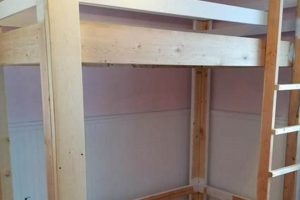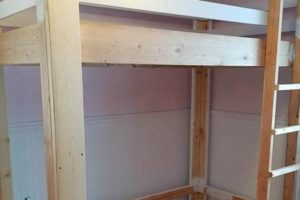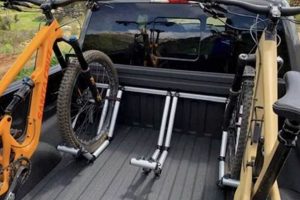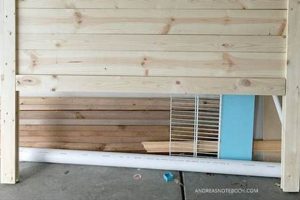A self-constructed framework designed to be mounted atop a pickup truck’s cargo area, enabling the secure transport of equipment and materials. Examples include structures built from lumber, steel tubing, or aluminum profiles, intended to carry items such as kayaks, bicycles, ladders, or camping gear.
These custom fabrications offer a cost-effective and adaptable solution for increasing a truck’s carrying capacity and organization. Historically, such solutions have emerged from a need to customize vehicles for specific trades and recreational activities, providing an alternative to commercially available options which may not meet precise requirements or budgets.
The following sections will detail essential considerations for planning and executing the construction of such a structure, including material selection, design principles, fabrication techniques, and safety protocols.
Construction Considerations for a Truck Bed Cargo Structure
The following outlines crucial guidance for the successful creation of a customized cargo management system for a pickup truck. Careful planning and execution are paramount.
Tip 1: Material Selection: Choose materials based on strength, weight, and corrosion resistance. Steel offers robust durability, while aluminum provides a lighter alternative. Lumber, while cost-effective, requires weather protection and may not offer the same structural integrity.
Tip 2: Design Planning: Develop a detailed design before commencing construction. Consider load capacity, mounting points, and accessibility. Blueprints or sketches are essential for accurate fabrication.
Tip 3: Accurate Measurements: Precise measurements of the truck bed are critical. Account for any existing bed liners or modifications. Inaccurate measurements can lead to fitting issues and structural instability.
Tip 4: Secure Mounting: Implement a robust mounting system. Options include bolting directly to the bed rails or utilizing existing factory mounting points. Ensure all connections are properly torqued.
Tip 5: Welding Techniques: If welding is involved, employ proper welding techniques and safety precautions. Ensure sufficient penetration and weld quality to avoid structural failures.
Tip 6: Surface Protection: Apply a protective coating to prevent corrosion. Painting, powder coating, or galvanizing can extend the lifespan of the structure.
Tip 7: Load Distribution: Distribute cargo evenly across the structure to avoid concentrated stress points. Uneven loading can compromise structural integrity.
Adherence to these guidelines ensures a safe, reliable, and functional cargo management system for a pickup truck.
The subsequent section will address common challenges and troubleshooting strategies associated with these custom fabrications.
1. Material Strength
Material strength is a foundational consideration in the design and construction of a truck bed cargo system. The selection of materials directly dictates the rack’s ability to withstand applied loads and environmental stressors, influencing its safety and longevity.
- Yield Strength and Load Capacity
Yield strength, the point at which a material begins to deform permanently, determines the maximum load the structure can bear without undergoing irreversible damage. For instance, steel possesses a significantly higher yield strength compared to aluminum, making it suitable for heavier loads. Improper material selection can result in structural failure and potential cargo loss.
- Tensile Strength and Fatigue Resistance
Tensile strength reflects a material’s ability to resist being pulled apart, while fatigue resistance indicates its ability to withstand repeated stress cycles. A structure subjected to constant vibration and fluctuating loads requires materials with high fatigue resistance to prevent cracking and eventual failure. Aluminum, although lighter, may exhibit lower fatigue resistance compared to steel under certain conditions.
- Weldability and Joint Strength
If welding is employed in the construction, the weldability of the selected material is crucial. The resulting weld joint must possess sufficient strength to withstand the same forces as the parent material. Incompatible materials or improper welding techniques can lead to weakened joints and structural instability. The strength of bolted joints must also be factored in if such methods are used.
- Corrosion Resistance and Environmental Factors
Materials must resist corrosion from exposure to weather elements, road salts, and other environmental factors. Rust or oxidation can significantly weaken a structure over time. Protective coatings, such as paint or powder coating, are essential for mitigating corrosion, particularly for materials like steel that are susceptible to rust. Material selection, considering local climate and conditions, is of utmost importance.
The interplay between material strength and these related factors is paramount in the design of a safe and effective truck bed cargo system. Selecting appropriate materials, considering their inherent properties, and implementing proper construction techniques ensures the structure can reliably perform its intended function under various conditions. The lack of attention to these details could create a hazardous condition for the vehicle and its contents.
2. Welding Integrity
Welding integrity is paramount to the structural soundness of a self-constructed truck bed cargo system. The strength and reliability of welded joints directly influence the overall load-bearing capacity and safety of the installation. Compromised welds can lead to catastrophic failure under load or vibration.
- Weld Penetration and Fusion
Adequate weld penetration is critical, ensuring the weld metal fuses completely with the base metal. Insufficient penetration creates a weak bond, susceptible to cracking under stress. Visual inspection, as well as non-destructive testing methods like dye penetrant testing, can assess weld penetration. A shallow weld, despite appearing visually sound, can easily fail under real-world conditions, such as carrying heavy equipment over uneven terrain.
- Material Compatibility and Filler Metal Selection
The welding process demands selecting appropriate filler metals compatible with the base materials being joined. Using incompatible filler metals can result in brittle welds prone to cracking or corrosion. For example, welding dissimilar metals, such as aluminum and steel, requires specific filler alloys and techniques to prevent galvanic corrosion and ensure a strong joint. A mismatch in filler metal and base material can create a weak point that drastically reduces the overall strength.
- Weld Bead Geometry and Quality
The shape and consistency of the weld bead significantly impact its strength. Consistent bead width, uniform ripples, and the absence of defects such as porosity or slag inclusions are indicative of a quality weld. Overly large or irregular beads can create stress concentrations, while porosity weakens the weld structure. A poorly formed weld bead suggests a lack of control or expertise, potentially compromising safety.
- Proper Welding Technique and Procedure
Employing correct welding techniques and following established welding procedures are essential. Preheating the base metal, using appropriate amperage and voltage settings, and maintaining a consistent travel speed contribute to weld integrity. Improper technique, such as excessive heat input or insufficient shielding gas coverage, can introduce defects and weaken the weld. Certified welders typically possess the necessary skills and knowledge to execute proper welding procedures.
In conclusion, the integrity of welds in a fabricated truck bed cargo system necessitates meticulous attention to detail, correct material selection, proper welding techniques, and rigorous inspection. The structural performance and safety of such a system rely heavily on the quality and reliability of its welded joints. Any compromise in weld quality can have severe consequences, potentially leading to cargo damage, vehicle accidents, or personal injury.
3. Mounting Security
The secure attachment of a self-fabricated truck bed cargo structure to the vehicle is of paramount importance. Insufficient or improperly executed mounting procedures can lead to instability, detachment, and potential hazards during vehicle operation. The following delineates critical facets of mounting security.
- Selection of Mounting Hardware
The choice of fasteners, brackets, and securing mechanisms directly impacts the structural integrity of the mounting system. High-grade bolts, appropriately sized for the load requirements, are essential. The use of inferior hardware or mismatched components can compromise the entire system’s reliability. For instance, using bolts with insufficient shear strength in high-stress areas can lead to fastener failure and subsequent detachment of the rack.
- Load Distribution and Mounting Point Placement
Strategic placement of mounting points is crucial for distributing the cargo load evenly across the truck bed and the fabricated structure. Concentrated loads at a single mounting point can induce excessive stress and lead to failure. Distributing the load over multiple points, strategically positioned to coincide with the truck bed’s structural supports, enhances stability and minimizes the risk of deformation. A structure that mounts exclusively to the bed rails, without considering underlying support structures, is more susceptible to damage under heavy loads.
- Corrosion Protection and Long-Term Durability
Exposure to weather elements and road salts can corrode mounting hardware, weakening the connections over time. Employing corrosion-resistant materials, such as stainless steel or applying protective coatings, is critical for ensuring long-term mounting security. Regular inspection and maintenance of the mounting system are necessary to identify and address any signs of corrosion before they compromise the structure’s integrity.
- Compatibility with Truck Bed Design
The mounting system must be compatible with the specific design and features of the truck bed. Some truck beds may have pre-existing mounting points or require specialized adapters to ensure a secure fit. Ignoring the bed’s unique characteristics can lead to improper mounting and instability. A rack designed for a truck bed with integrated tie-down rails may not be suitable for a truck bed without such features, requiring significant modifications or a completely different mounting approach.
The combined effect of these facets determines the overall mounting security of a self-constructed truck bed cargo management system. A system that addresses these considerations comprehensively is more likely to provide a stable, safe, and durable solution for cargo transport. Ignoring any of these factors can elevate the risk of structural failure and potential hazards. Rigorous planning and meticulous execution are fundamental to establishing a secure and reliable mounting system.
4. Load Distribution
Effective load distribution is a critical consideration in the design and utilization of a self-constructed truck bed cargo management system. Proper distribution minimizes stress concentrations, enhances stability, and ensures the safe transport of equipment and materials. Ignoring load distribution principles can compromise the structural integrity of the frame and the vehicle itself.
- Uniform Load Placement
Distributing weight evenly across the structure minimizes stress on individual components. Concentrating loads in specific areas can lead to localized stress fractures or bending. For instance, placing heavy equipment directly over a single support member increases the risk of failure compared to distributing the same weight across multiple supports. Proper planning during the rack’s design phase is vital to accommodate expected load profiles.
- Center of Gravity Considerations
The position of the cargo’s center of gravity significantly affects vehicle handling and stability. A high center of gravity can increase the risk of rollovers, particularly during cornering or sudden maneuvers. Placing heavier items lower and closer to the truck bed’s center line improves stability and reduces the likelihood of adverse handling characteristics. Improperly managing the center of gravity can create unsafe driving conditions.
- Dynamic Load Factors
Dynamic loads, arising from acceleration, braking, and uneven road surfaces, introduce additional stresses on the structure. Securing cargo to prevent shifting during transit is essential for mitigating these dynamic forces. Loose or unrestrained cargo can shift weight unpredictably, exceeding the design limits of the rack and creating instability. Tie-down straps, cargo nets, and other securing mechanisms are vital for managing dynamic loads.
- Material Properties and Load Limits
The load-bearing capacity of the structure is directly related to the material properties of its components. Exceeding the recommended load limits for the materials used can lead to structural failure. Steel, with its higher yield strength, can withstand greater loads compared to aluminum or wood. Accurate calculations of load limits and appropriate material selection are critical for ensuring safe operation. A fabricated structure, regardless of its robust appearance, is only as strong as its weakest link.
These facets demonstrate that conscientious attention to load distribution is fundamental to the safe and effective use of a self-constructed truck bed cargo system. A well-designed and properly loaded structure enhances the utility of the truck while minimizing the risks associated with cargo transport. Neglecting these principles can result in structural damage, vehicle instability, and potentially hazardous conditions.
5. Corrosion Resistance
Corrosion resistance is a critical factor in the design and longevity of any self-constructed truck bed cargo structure. Exposure to environmental elements and road treatments can significantly degrade structural integrity over time, making corrosion prevention a primary concern.
- Material Selection
The choice of construction material significantly impacts the rack’s resistance to corrosion. Steel, while strong, is susceptible to rust. Aluminum offers superior corrosion resistance but may require specific alloys to achieve comparable strength. Lumber, if used, requires extensive sealing and protection to prevent rot. The material selection dictates the extent of additional protective measures required.
- Protective Coatings
The application of protective coatings forms a crucial barrier against corrosion. Painting, powder coating, and galvanizing are common methods. Each offers varying levels of protection and durability. Powder coating, for example, provides a robust, impact-resistant finish. The selection of the appropriate coating depends on environmental conditions and anticipated usage.
- Joint Protection
Joints and connections are particularly vulnerable to corrosion due to potential moisture accumulation and galvanic reactions between dissimilar metals. Sealing joints with corrosion-resistant compounds and using compatible fasteners are essential. Improperly sealed joints can become focal points for rust development, leading to structural weakening. Regular inspection and maintenance of joints are necessary to ensure continued protection.
- Environmental Considerations
The operating environment significantly influences the rate of corrosion. Coastal regions with high salt concentrations and areas with frequent road salt applications during winter necessitate more robust corrosion protection measures. The specific environmental conditions dictate the choice of materials, coatings, and maintenance schedules for the rack. Structures operating in harsh environments require more frequent inspections and maintenance to prevent corrosion.
These considerations highlight the importance of addressing corrosion resistance in the construction of a truck bed cargo system. A comprehensive approach, encompassing material selection, protective coatings, and joint protection, is essential for ensuring the long-term durability and safety of the structure. Neglecting these factors can lead to premature failure and compromise the integrity of the entire system.
Frequently Asked Questions
The following addresses common inquiries and misconceptions regarding self-constructed truck bed cargo management systems, providing clarity on design, construction, and safety considerations.
Question 1: What are the primary advantages of a self-constructed truck bed cargo structure compared to commercially available options?
Self-constructed systems offer customization tailored to specific needs and budget constraints. They allow for the integration of unique features and dimensions not readily available in commercial products. Furthermore, the cost of materials may be lower than the purchase price of pre-fabricated racks.
Question 2: What tools and equipment are essential for constructing a safe and reliable truck bed cargo structure?
Essential tools include measuring devices, cutting tools (e.g., saw, angle grinder), welding equipment (if applicable), drilling equipment, and appropriate safety gear (e.g., welding helmet, safety glasses, gloves). Access to a level and square work surface is also crucial.
Question 3: What are the key safety considerations when designing and building a self-constructed truck bed cargo structure?
Safety considerations include selecting materials with adequate load-bearing capacity, ensuring proper welding techniques (if applicable), securing the structure to the truck bed with appropriate mounting hardware, and distributing cargo weight evenly to prevent instability.
Question 4: How should one determine the appropriate load capacity for a self-constructed truck bed cargo structure?
Load capacity should be determined by calculating the structural strength of the chosen materials and the limitations of the truck bed itself. It is imperative to consult manufacturer specifications for material strength and vehicle load ratings to avoid exceeding safe operating limits.
Question 5: What are the potential legal liabilities associated with using a self-constructed truck bed cargo structure?
Legal liabilities may arise if the structure is poorly constructed, improperly mounted, or overloaded, leading to accidents or property damage. It is prudent to consult with legal counsel regarding potential liabilities and insurance coverage.
Question 6: How does one properly maintain a self-constructed truck bed cargo structure to ensure long-term durability?
Regular maintenance includes inspecting the structure for signs of corrosion, checking the tightness of mounting hardware, and applying protective coatings as needed. Damaged or weakened components should be repaired or replaced promptly to prevent structural failure.
These responses provide a foundational understanding of the considerations involved in creating a self-constructed truck bed cargo system. Diligence in design, construction, and maintenance is essential for ensuring safe and reliable operation.
The concluding section will offer a summary of key takeaways and actionable insights for readers pursuing this endeavor.
Conclusion
The preceding analysis has detailed the complexities inherent in the construction of a truck bed cargo system. Material selection, welding integrity, mounting security, load distribution, and corrosion resistance represent crucial elements that demand rigorous consideration. The successful creation of such a system necessitates a comprehensive understanding of engineering principles and practical fabrication skills.
The decision to undertake a self-constructed project requires careful deliberation. While offering customization and potential cost savings, this endeavor demands a commitment to precision and safety. Adherence to established guidelines and meticulous attention to detail are paramount. The ultimate responsibility for the system’s structural integrity and safe operation rests with the individual constructor.







